Wind Velocity Vertical Extrapolation by Extended Power Law
Abstract
Wind energy gains more attention day by day as one of the clean renewable energy resources. We predicted wind speed vertical extrapolation by using extended power law. In this study, an extended vertical wind velocity extrapolation formulation is derived on the basis of perturbation theory by considering power law and Weibull wind speed probability distribution function. In the proposed methodology not only the mean values of the wind speeds at different elevations but also their standard deviations and the cross-correlation coefficient between different elevations are taken into consideration. The application of the presented methodology is performed for wind speed measurements at Karaburun/Istanbul, Turkey. At this location, hourly wind speed measurements are available for three different heights above the earth surface.
1. Introduction
Wind energy, as one of the main renewable energy sources in the world, attracts attention in many countries as the efficient turbine technology develops. Wind speed extrapolation might be regarded as one of the most critical uncertainty factor affecting the wind power assessment, when considering the increasing size of modern multi-MW wind turbines. If the wind speed measurements at heights relevant to wind energy exploitation lacks, it is often necessary to extrapolate observed wind speeds from the available heights to turbine hub height [1], which causes some critical errors between estimated and actual energy output, if the wind shear coefficient, n, cannot be determined correctly. The difference between the predicted and observed wind energy production might be up to 40%, due to turbulence effects, time interval of wind data measurement, and the extrapolation of the data from reference height to hub heights [2].
In the literature, the wind shear coefficient is generally approximated between 0.14 and 0.2. However, in real situations, a wind shear coefficient is not constant and depends on numerous factors, including atmospheric conditions, temperature, pressure, humidity, time of day, seasons of the year, the mean wind speed, direction, and nature of terrain [3–6]. Table 1 demonstrates the various wind shear coefficients for different types of topography and geography [3].
| Terrain type | |
|---|---|
| Lake, ocean, and smooth-hard ground | 0.1 |
| Foot-high grass on level ground | 0.15 |
| Tall crops, hedges, and shrubs | 0.2 |
| Wooded country with many trees | 0.25 |
| Small town with some trees and shrubs | 0.3 |
| City area with tall buildings | 0.4 |
According to the calculations of wind resource analysis program (WRAP) report, in 39 different regions, out of 7082 different wind shear coefficients, 7.3% are distributed between 0 and 0.14 and 91.9% above 0.14, while 0.8% are calculated as negative [7], due to the measurements error.
Different methods have been developed to analyze wind speed profiles, such as power, logarithmic, and loglinear laws [8]. Besides, in the literature various studies are conducted in order to estimate wind shear coefficient in the power law only if surface data is available at hand [9–11].
The wind speed undergoes repeated changes, as a result of which the roughness and friction coefficients also change depending on landscape features, the time of the day, the temperature, height and wind direction. The uncertainty is inhereted in the wind speed data and its extrapolation to the hub height should be considered carefully and preciously [12]. Moreover, this uncertainty is exacerbated in the offshore environment by the inclusion of the dynamic surface [13]. Therefore, the mean wind speed profile of the logarithmic type is developed by applying a stability correction for offshore sites [14].
It is crucial point for energy investors to accurately predict the average wind speed at different wind turbine hub heights and make realistic feasibility projects for these heights. In this study, a simple but effective methodology on the basis of the perturbation theory is presented in order to derive an extended power law for the vertical wind speed extrapolation and then the Weibull probability distribution function (pdf) parameters. It is observed that on the contrary to the classical approach not only the means of wind speeds are at different elevations, but also the standard deviations and the cross-correlation coefficient should be taken into consideration, if the wind speeds at different elevations are not independent from each other.
2. Power Law
3. Extended Power Law


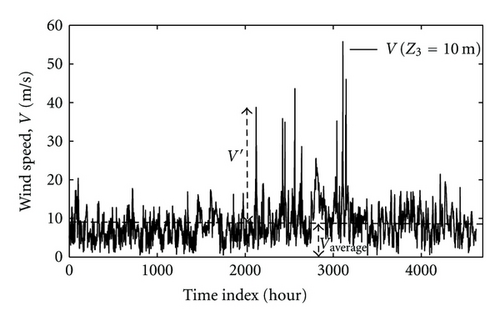
4. Weibull Distribution Parameter Extrapolation
It is the purpose of this paper to present detailed extrapolation formulations for the Weibull pdf parameters on the basis of perturbation approach and power law of vertical wind velocity variation.
5. Application
In this paper, wind speed data from the Karaburun wind station in Istanbul, Turkey are used, and this station is located at latitude 41.338′ N and longitude 28.677′ E (Figure 2). At this location hourly, wind speed measurements are available at three different heights (10 m, 20 m, and 30 m) above the earth surface. The average wind speed, the standard deviation, and the coefficient of variation for each height are given in Table 2. Wind speed data measurement empirical relative frequency distribution functions (histograms) at 10 m, 20 m, and 30 m are given together with the theoretically fitted Weibull pdf’s in Figure 3 for each height. A good fit between the empirical and theoretical counterparts at different heights are obtained through the Kolmogorov-Smirnov test at significance level of 5%. Table 1 presents the Weibull pdf parameters, c (scale) and k (shape). The scale parameters are 8.32, 8.77, and 9.54 for heights of 10 m, 20 m, and 30 m, respectively. The shape parameters are determined as 2, 2.11, and 2.06, respectively for the same heights.
Height (m) |
Mean speed (m/s) |
Standard deviation (m/s) |
Coefficient of variation | Weibull pdf parameters | |
|---|---|---|---|---|---|
| c | k | ||||
| 10 | 7.37 | 3.86 | 0.52 | 8.32 | 2.0 |
| 20 | 7.75 | 3.88 | 0.50 | 8.77 | 2.11 |
| 30 | 8.44 | 4.30 | 0.51 | 9.54 | 2.06 |
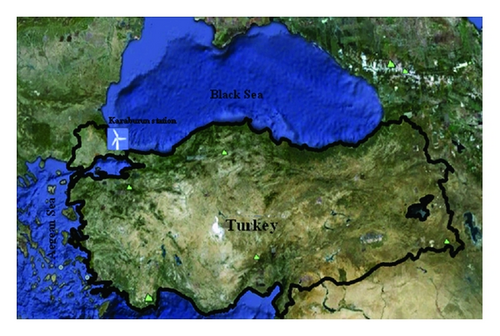
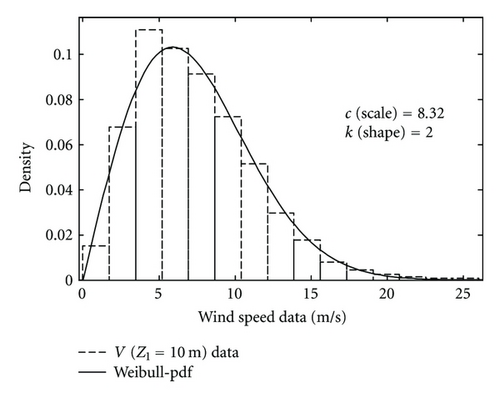
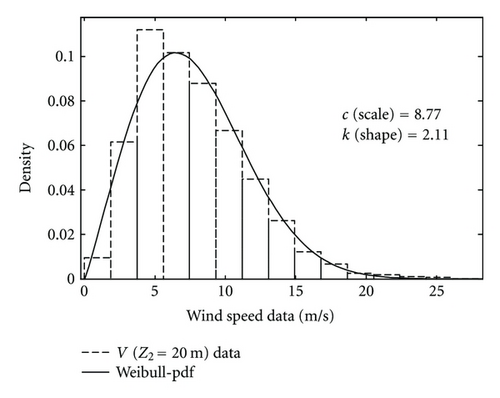
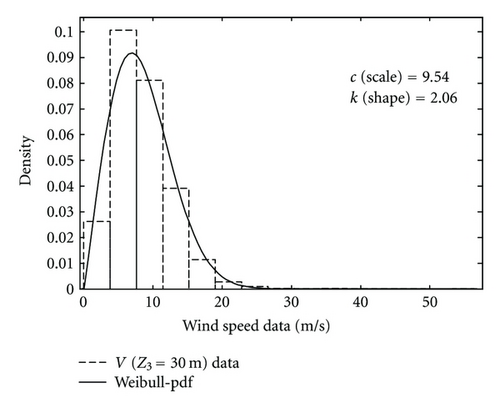
It is clear from this table that as the height increases, the mean speed and standard deviation increase as expected. Coefficient of variation varies with different heights as in Table 2. This shows also that the closer the height to the earth surface, the greater is the instability of the air. The power law exponent, n, calculation between any two heights are found from (18) and classically from (19); and they are presented in Table 3.
For both classical and Weibull pdf approaches the greatest value lies between 20 m and 30 m, whereas the lowest value is between 10 m and 20 m. For all levels, the average values are 0.1360 and 0.1238 for classical and extended power laws, respectively.
6. Conclusions
A simple methodology on the basis of the perturbation theory is presented in order to derive an extended power law for the vertical wind speed extrapolation and then the Weibull probability distribution parameters. It is observed that on the contrary to the classical approach not only the means of wind speeds are at different elevations, but also the standard deviations and the cross-correlation coefficient should be taken into consideration, if the wind speeds at different elevations are not independent from each other. Otherwise, consideration of the classical power law in the calculations embodies the assumption that there are no fluctuations in the wind speed time series around their respective mean values. The necessary formulations for the Weibull distribution function wind speed parameter extrapolations are presented in this paper. The application of the developed methodology is presented for Karaburun, Istanbul, near the Black Sea coast wind speed measurement station data at three different levels.




